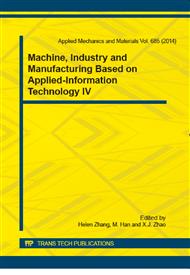p.265
p.271
p.275
p.279
p.284
p.289
p.294
p.298
p.302
Intuitive Control System for Industrial Robot Application Using Smartphone
Abstract:
Most of industrial robots are still programmed using the typical teaching process, through the use of the robot teach pendant. In order to simplify the teaching process, an intuitive control system using smartphone is proposed. The smartphone has multiple motion and position sensors in it. When smartphone is being held in hand, the motion sensors capture posture of hand which the input of robot controller is depended on. The smartphone and robot controller communicates wirelessly through TCP/IP protocol. The system can complete typical operations of teaching process. Compared with the typical teaching process, this system is intuitive and much easier to use.
Info:
Periodical:
Pages:
284-288
Citation:
Online since:
October 2014
Authors:
Keywords:
Price:
Сopyright:
© 2014 Trans Tech Publications Ltd. All Rights Reserved
Share:
Citation:


